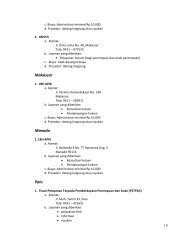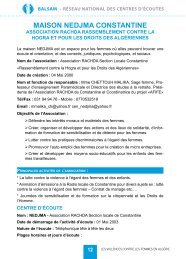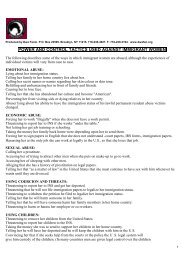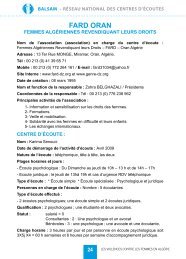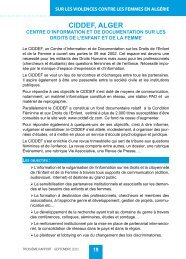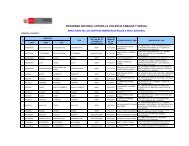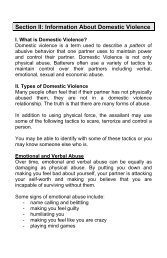Working with Battered Women: a Handbook for ... - Hot Peach Pages
Working with Battered Women: a Handbook for ... - Hot Peach Pages
Working with Battered Women: a Handbook for ... - Hot Peach Pages
Create successful ePaper yourself
Turn your PDF publications into a flip-book with our unique Google optimized e-Paper software.
In<strong>for</strong>mation Means ChoicesBecause leaving is so difficult, it is most often not a one-time event. It is a process. It isnormal <strong>for</strong> an abused woman to leave and return many times. Each time she leaves is a test:• will he stalk me and hurt or kill me (or my family) like he promised?• will he change and get counselling like he promised?• can I make it on my own? will I be able to get groceries, <strong>with</strong> three kids under five and nocar, in the middle of winter?The stage of the process she is in when you see her will determine her response to yourassistance. But <strong>with</strong> in<strong>for</strong>mation comes choice. Perhaps she just needs to know this happens toother women. Perhaps she just needs to know where to go <strong>for</strong> help. You can provide her <strong>with</strong>that in<strong>for</strong>mation.There has been reluctance on the part of health care providers to develop interventionprocedures and protocols around domestic violence. This reluctance stems in large part from theearliest tradition that this is a private matter between a husband and his wife, and from a morerecent belief that it is not a health care issue but rather a social problem that is the responsibility ofsocial service agencies and community groups. But the statistics (see Appendix C) tell us thatdomestic violence is a health care issue. The ongoing stress of living in an abusive situation, aswell as the physical and emotional consequences of violence, have many serious healthramifications. Helping women who are abused requires a partnership between the health careprofessions, social services, justice services and community groups. Each of these partners mustdevelop meaningful intervention procedures and protocols that meet the needs of abused women.In the late 1980’s, an Inter-Hospital Committee on Domestic Violence developed a bookletentitled "Spousal Abuse: In<strong>for</strong>mation and Protocol <strong>for</strong> Hospitals". The booklet containedcopies of Adult Concern Forms and a model protocol. The Adult Concern Forms provided aspecific <strong>for</strong>mat <strong>for</strong> documenting on the patient's medical file confirmed and suspected cases ofbattering. The "Model Protocol" was intended to provide hospitals or medical facilities <strong>with</strong> a stepby step process to follow in order to deal <strong>with</strong> suspected or confirmed cases of the abuse of womenby their partners. The protocol dealt <strong>with</strong> Identification, Registration, Assessment Intervention,Follow-up and Resources. Although this booklet is out of print, the Provincial Department of Healthhad distributed at least one copy of this booklet to each hospital and Health Districts should sincehave each worked out their own protocols around this issue.11



